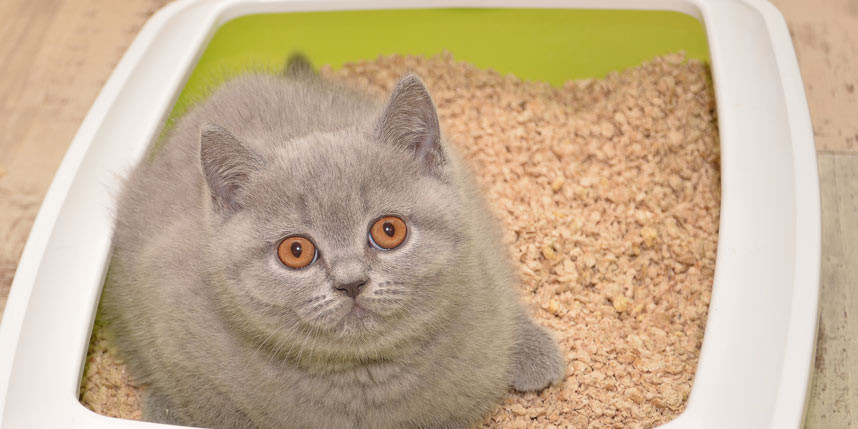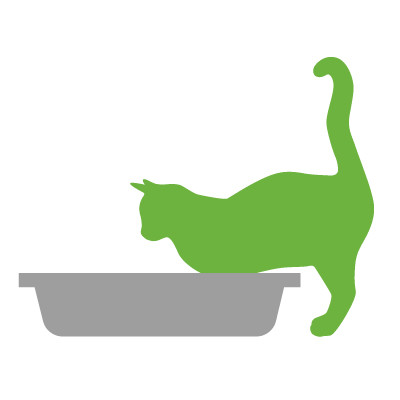Are you puzzled about the right amount of cat litter to use in your feline friend’s litter box? It’s a common question among cat owners! At solcat.net, we understand the importance of creating a comfortable and clean environment for your cat. Using the right amount of cat litter is essential for your cat’s hygiene and can prevent unwanted behaviors. This guide will help you determine the ideal cat litter depth, select the right type, and maintain a fresh, odor-free litter box, while also helping you avoid common litter box problems.
1. Understanding the Importance of Proper Cat Litter Depth
How much cat litter should you use in your cat’s litter box? Using the right amount of cat litter is crucial for both your cat’s comfort and your home’s cleanliness. Too little litter can lead to inadequate odor control and a messy litter box, while too much can make it difficult for your cat to move around and cover their waste properly. According to Dr. Sarah Hodges, a feline behaviorist at the American Animal Hospital Association (AAHA), maintaining the correct litter depth is a key factor in encouraging positive litter box habits.
Here’s why getting the cat litter depth right matters:
- Odor Control: An adequate amount of cat litter helps to absorb urine and cover solid waste, reducing unpleasant odors in your home.
- Hygiene: Proper litter depth allows your cat to bury their waste effectively, minimizing the risk of bacterial growth and maintaining a cleaner environment.
- Comfort: Cats prefer a litter box that feels natural and comfortable. The right amount of litter allows them to dig and cover their waste as they would in the wild.
- Behavioral Issues: Using the correct amount of cat litter can prevent litter box aversion and other behavioral problems.
2. Determining the Ideal Cat Litter Depth
What is the ideal depth of cat litter for most cats? Generally, 2 to 3 inches (5 to 7.5 cm) of cat litter is recommended. This depth allows cats to dig, cover their waste, and feel comfortable in their litter box. However, the ideal depth can vary depending on the type of litter and your cat’s preferences.
Here’s a detailed breakdown to help you determine the right depth:
2.1. General Recommendation: 2-3 Inches
For most cats and litter types, 2 to 3 inches of litter is the sweet spot. This depth provides enough material for absorption and coverage without being too deep for your cat to navigate.
2.2. Clumping Litter
Clumping litters, such as clay or bentonite-based litters, require a slightly deeper layer to form solid clumps effectively. Aim for at least 3 inches to prevent urine from reaching the bottom of the box, making it easier to scoop and clean.
2.3. Non-Clumping Litter
Non-clumping litters, like wood, paper, or silica gel crystals, can work with a slightly shallower layer. About 2 inches is usually sufficient, as these litters are designed to absorb urine rather than clump it. However, you may need to change the litter more frequently to maintain cleanliness.
2.4. Adjusting Based on Your Cat’s Preferences
Pay attention to your cat’s behavior. If they seem hesitant to use the litter box or are making a mess, try adjusting the depth. Some cats prefer a deeper layer for digging, while others prefer a shallower one.
2.5. Litter Box Size
The size of your litter box also influences the amount of litter needed. A larger litter box will require more litter to achieve the recommended depth. Ensure that the litter box is appropriately sized for your cat to move around comfortably.
 Cat using litter box
Cat using litter box
Alt text: Cat using a clean litter box with adequate litter depth.
3. Signs You’re Using Too Much Cat Litter
How can you tell if you’re using too much cat litter? While providing enough litter is essential, using too much can create problems. Here are some common signs that you might be overdoing it with the litter:
3.1. Cat Slipping and Sliding
If your cat appears unsteady or slips and slides when using the litter box, there might be too much loose litter. This can make your cat feel insecure and uncomfortable. According to a study by the Cornell Feline Health Center, cats prefer stable surfaces in their litter boxes.
 Cat slipping in litter box
Cat slipping in litter box
Alt text: Cat slipping and sliding in a litter box with too much loose litter.
3.2. Cat Only Going Halfway In
A cat that only steps partially into the litter box may be avoiding the deep litter. They might feel overwhelmed or unable to find a comfortable spot. This behavior can lead to accidents outside the box.
 Cat halfway in litter box
Cat halfway in litter box
Alt text: Cat only stepping halfway into the litter box, possibly due to too much litter.
3.3. Excessive Litter Scattering
Does your cat fling litter everywhere when digging? Overly enthusiastic digging can be a sign that there is too much litter in the box. Cats may dig more vigorously to create a comfortable space, resulting in scattered litter.
 Cat scattering litter
Cat scattering litter
Alt text: Cat flinging litter outside the litter box due to excessive digging.
3.4. Difficulty Cleaning
If you find it challenging to scoop and clean the litter box, with heavy, hard clumps forming at the bottom, you might be using too much litter. This can also be a sign that the litter type is not suitable for your needs.
3.5. Increased Odor
Paradoxically, using too much litter can sometimes lead to increased odor. If the litter is too deep, it may not be properly aerated, allowing bacteria to thrive and produce unpleasant smells.
4. Signs You’re Not Using Enough Cat Litter
What happens if you don’t use enough cat litter? Just as too much litter can cause problems, using too little can also lead to undesirable outcomes. Here are some signs that you might need to increase the amount of litter in your cat’s box:
4.1. Strong Odor
One of the most obvious signs of insufficient litter is a strong, lingering odor. If the litter layer is too thin, it won’t effectively absorb urine or cover solid waste, leading to increased smells.
4.2. Wet Litter Box Bottom
If you notice that the bottom of the litter box is frequently wet or sticky, you’re likely not using enough litter. Urine is seeping through the thin layer and accumulating at the bottom.
4.3. Clumps Sticking to the Box
With too little litter, urine clumps can stick to the sides and bottom of the box, making cleaning difficult and potentially creating a breeding ground for bacteria.
4.4. Cat Avoiding the Litter Box
Cats are fastidious creatures and may avoid using a litter box that is not adequately maintained. If your cat starts eliminating outside the box, it could be a sign that they are unhappy with the litter conditions.
4.5. Frequent Litter Changes
If you find yourself needing to change the litter box more frequently than usual, it could be because the thin layer of litter is becoming saturated quickly.
5. Choosing the Right Type of Cat Litter
What kind of cat litter should you choose? The type of cat litter you choose significantly impacts how much you should use and how often you need to change it. Here’s a rundown of the most common types of cat litter:
| Litter Type | Description | Ideal Depth | Pros | Cons |
|---|---|---|---|---|
| Clumping Clay | Made from bentonite clay that forms solid clumps when wet. | 3 inches or more | Excellent clumping, good odor control, widely available. | Can be dusty, heavy, non-biodegradable. |
| Non-Clumping Clay | Absorbs urine but doesn’t form clumps. | 2 inches | Affordable, readily available. | Poor odor control, requires frequent changes, can be dusty. |
| Silica Gel Crystals | Highly absorbent crystals that trap urine and odors. | 2 inches | Excellent odor control, low dust, long-lasting. | Can be expensive, some cats dislike the texture. |
| Wood Litter | Made from wood shavings or pellets. | 2-3 inches | Eco-friendly, good odor control, low dust. | Can be bulky, some cats don’t like the texture. |
| Paper Litter | Made from recycled paper, often in pellet form. | 2-3 inches | Eco-friendly, low dust, good for cats with allergies. | Can be less effective at odor control, may require more frequent changes. |
| Plant-Based Litter | Made from corn, wheat, or other plant materials. | 2-3 inches | Eco-friendly, good odor control, lightweight. | Can be more expensive, may attract bugs if not stored properly. |
5.1. Clumping vs. Non-Clumping Litter
Clumping litters are designed to form solid clumps when they come into contact with urine. This makes it easy to scoop out the waste and maintain a clean litter box. Clumping litters generally require a slightly deeper layer to function effectively.
Non-clumping litters absorb urine but do not form solid clumps. These litters require more frequent changes to prevent odor buildup and maintain hygiene. A slightly shallower layer can be used with non-clumping litters.
5.2. Considering Your Cat’s Health and Preferences
Some cats have allergies or sensitivities to certain types of litter. If your cat is sneezing, coughing, or showing signs of skin irritation, consider switching to a hypoallergenic litter like paper or wood.
Also, pay attention to your cat’s preferences. Some cats prefer the texture of clay litter, while others prefer the softness of paper or wood. Offering a variety of litter types can help you determine what your cat likes best.
5.3. Exploring Eco-Friendly Options
If you’re concerned about the environmental impact of cat litter, consider using eco-friendly options like wood, paper, or plant-based litters. These litters are biodegradable and sustainable, making them a great choice for environmentally conscious cat owners.
6. Maintaining a Clean and Fresh Litter Box
How often should you clean the cat litter box? Regular cleaning and maintenance are crucial for keeping your cat’s litter box fresh and inviting. Here are some tips for maintaining a clean and odor-free litter box:
6.1. Scooping Daily
Scoop the litter box at least once a day to remove solid waste and clumps. This helps to prevent odor buildup and maintain a clean environment for your cat.
6.2. Changing the Litter Regularly
Even with daily scooping, the litter box needs to be completely emptied and cleaned regularly. How often you need to do this depends on the type of litter you use:
- Clumping Litter: Change the litter every 2-3 weeks.
- Non-Clumping Litter: Change the litter every 1-2 weeks.
- Silica Gel Crystals: Change the litter every 3-4 weeks.
6.3. Cleaning the Litter Box
When you change the litter, thoroughly clean the litter box with mild soap and water. Avoid using harsh chemicals or scented cleaners, as these can be irritating to cats.
6.4. Using a Litter Box Liner
Consider using a litter box liner to make cleaning easier. Liners can be lifted out and discarded, reducing the need for scrubbing.
6.5. Choosing the Right Location
Place the litter box in a quiet, accessible location away from your cat’s food and water. Cats prefer privacy when using the litter box.
Alt text: A clean and well-maintained cat litter box.
7. Troubleshooting Common Litter Box Problems
What should you do if your cat is having litter box problems? Even with the best litter and maintenance routine, some cats may develop litter box issues. Here are some common problems and how to address them:
7.1. Cat Eliminating Outside the Box
If your cat is eliminating outside the box, it could be due to a variety of factors, including:
- Medical Issues: Urinary tract infections, kidney problems, or other medical conditions can cause cats to eliminate outside the box. Consult your veterinarian to rule out any underlying health issues.
- Litter Box Aversion: Cats may avoid the litter box if it is dirty, smelly, or in an undesirable location. Make sure the litter box is clean and accessible.
- Stress: Stress or anxiety can also lead to litter box problems. Provide your cat with a safe and comfortable environment.
7.2. Cat Spraying
Spraying is a common behavior in cats, especially unneutered males. It involves marking territory with urine. Neutering or spaying your cat can help to reduce spraying.
7.3. Cat Refusing to Use a New Litter Box
If you’ve recently switched litter boxes, your cat may be hesitant to use it. Try placing some of the old litter in the new box to help your cat adjust.
7.4. Cat Refusing to Use a Specific Type of Litter
Some cats are particular about the type of litter they use. If your cat refuses to use a specific type of litter, try switching to a different one.
8. Expert Tips for Cat Litter Success
What are some expert tips for cat litter success? Here are some additional tips from feline experts to help you achieve litter box success:
- Provide Multiple Litter Boxes: The general rule is to have one litter box per cat, plus one extra. This ensures that each cat has access to a clean litter box.
- Choose the Right Litter Box: Litter boxes come in a variety of shapes and sizes. Choose a litter box that is appropriate for your cat’s size and mobility.
- Consider a Covered Litter Box: Some cats prefer the privacy of a covered litter box. However, make sure the box is well-ventilated to prevent odor buildup.
- Avoid Scented Litters: Scented litters can be irritating to cats. Opt for unscented litters to avoid deterring your cat from using the box.
- Consult a Veterinarian or Feline Behaviorist: If you’re struggling with litter box problems, don’t hesitate to seek professional help. A veterinarian or feline behaviorist can provide valuable insights and guidance.
9. How Solcat.net Can Help You with Cat Care
Looking for more information and resources about cat care? At solcat.net, we are dedicated to providing you with the most accurate and up-to-date information about cat health, behavior, and care. We offer a wide range of articles, guides, and resources to help you become the best cat parent you can be.
9.1. Explore Our Comprehensive Cat Care Guides
Our website features comprehensive guides on various aspects of cat care, including:
- Nutrition: Learn about the best diet for your cat’s age, breed, and health condition.
- Health: Get information about common cat diseases, vaccinations, and preventive care.
- Behavior: Understand your cat’s behavior and how to address common issues like scratching, biting, and spraying.
- Grooming: Learn how to keep your cat’s coat clean and healthy.
- Play and Enrichment: Discover fun and engaging activities to keep your cat mentally and physically stimulated.
9.2. Connect with Our Community of Cat Lovers
Join our community of cat lovers to share your experiences, ask questions, and connect with other cat owners. Our forums and social media channels are a great place to find support and advice.
9.3. Stay Up-to-Date with the Latest Cat News and Research
We regularly update our website with the latest news and research about cats. Stay informed about new products, studies, and events in the cat world.
9.4. Find Trusted Veterinarians and Services
Use our directory to find trusted veterinarians, groomers, and other pet care services in your area. We only recommend professionals who meet our high standards for quality and care.
10. Frequently Asked Questions (FAQs) About Cat Litter
Do you still have questions about cat litter? Here are some frequently asked questions to help you better understand how to use cat litter effectively:
10.1. How Often Should I Completely Change the Cat Litter?
The frequency of complete litter changes depends on the type of litter you use. Clumping litters should be changed every 2-3 weeks, non-clumping litters every 1-2 weeks, and silica gel crystals every 3-4 weeks.
10.2. Can I Flush Cat Litter Down the Toilet?
No, most cat litters should not be flushed down the toilet. Clumping litters can clog pipes, and non-biodegradable litters can harm the environment. Check the manufacturer’s instructions for disposal guidelines.
10.3. What Should I Do If My Cat Starts Eliminating Outside the Litter Box?
If your cat starts eliminating outside the litter box, consult your veterinarian to rule out any medical issues. Also, ensure that the litter box is clean, accessible, and in a desirable location.
10.4. Are Scented Litters Safe for Cats?
Scented litters can be irritating to cats and may deter them from using the litter box. It’s best to use unscented litters to avoid any potential problems.
10.5. How Can I Reduce Litter Box Odor?
To reduce litter box odor, scoop the litter daily, change the litter regularly, and use a high-quality litter with good odor control properties. You can also try using a litter box deodorizer.
10.6. What Is the Best Type of Litter for Kittens?
For kittens, it’s best to use a non-clumping litter to prevent them from ingesting it. Clumping litters can cause intestinal blockages if swallowed.
10.7. Can I Use Baking Soda to Deodorize the Litter Box?
Yes, you can sprinkle baking soda in the bottom of the litter box before adding litter to help absorb odors.
10.8. How Do I Transition My Cat to a New Type of Litter?
To transition your cat to a new type of litter, gradually mix the new litter with the old litter over a period of several days. This will help your cat adjust to the new texture and scent.
10.9. What Size Litter Box Should I Use for My Cat?
The litter box should be at least 1.5 times the length of your cat. This allows your cat to turn around comfortably and dig without making a mess.
10.10. Where Should I Place the Litter Box?
Place the litter box in a quiet, accessible location away from your cat’s food and water. Cats prefer privacy when using the litter box.
By following these guidelines, you can ensure that you’re using the right amount of cat litter and providing your feline friend with a clean, comfortable, and inviting litter box. Visit solcat.net for more expert tips and resources on cat care!
We hope this comprehensive guide has been helpful. Remember, a happy cat means a happy home!

